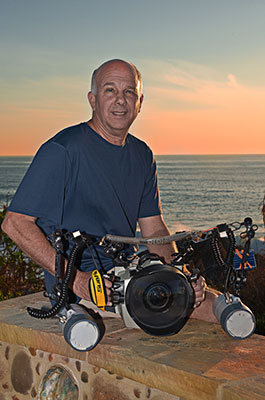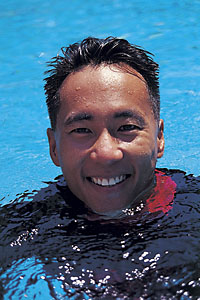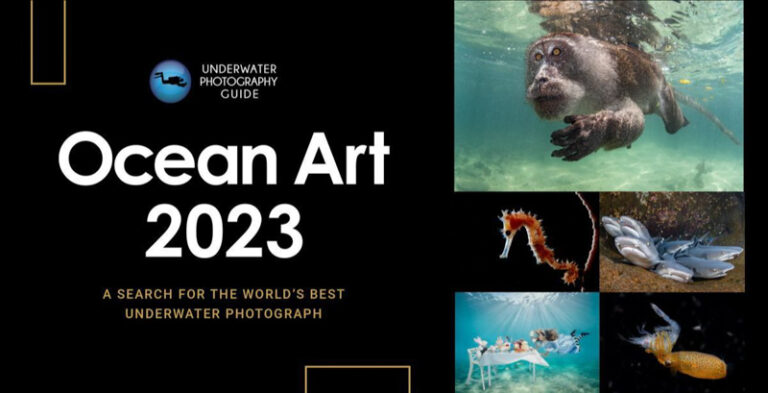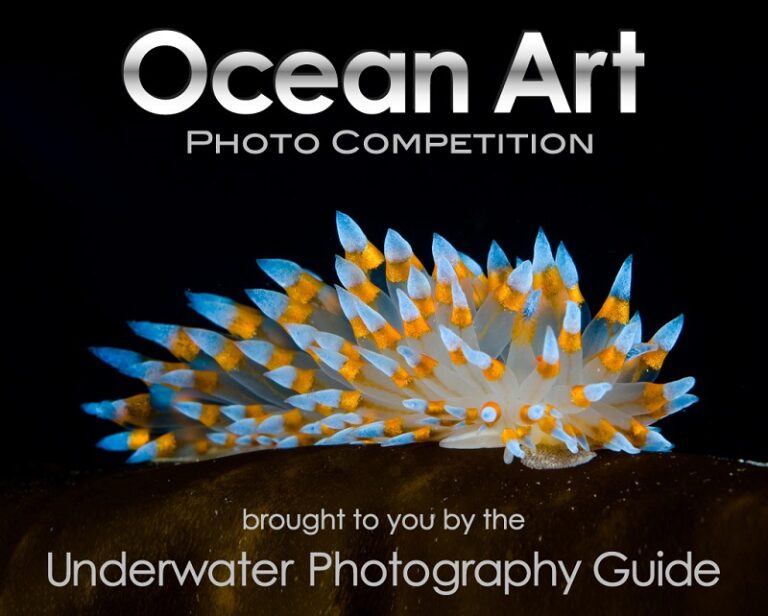
The Ocean Art 2022 Underwater Photo Competition is the 11th annual competition hosted by the Underwater Photography Guide. Ocean Art is world’s most prestigious and best endowned underwater photo contest, with over $100,000 in prizes awarded this year!
As global travel opens up, the winning images from this year’s competition have been stunning. 14 categories, including a new smartphone category, ensure an exciting competition for all disciplines of underwater photography. If you haven’t yet, be sure to check out the 2022 Ocean Art Contest Winners.
Ocean Art 2022 would not be possible without our esteemed judging panel – each of whom is a leader in their field with decades of experience and some of the most prestigious awards in the diving, photo, and video industries.
Here is what our judges had to say about this year’s competition.
Marty Snyderman

The author of Dive Training magazine’s Behind the Lens column, Marty Snyderman has made his living as an underwater photographer, photography instructor, author, and speaker for close to 40 years. He has won many prestigious awards (including an Emmy) and has been featured in many top publications worldwide.
As has been the case every year that I have served as a judge, I thoroughly enjoyed doing my part in the 2022 Ocean Art Photography contest. Certainly, I want to congratulate all the category winners and everyone else who had an image or images recognized in any way. I also want to thank everyone who entered a photograph.
We had more images to judge this year than last year. I think that it’s a result of more and more people pursuing underwater photography and people getting out and going diving after a long period of heeding the “stay at home” Covid warnings. In any case, the increased number of photographs meant more high-quality images. This, of course, makes the judging more challenging. No doubt about it, judges Mark Strictland, Tony Wu, and I saw a lot of beautiful photographs.
While Tony, Mark, and I generally agreed on the images that we want to recognize as winners and with the honorable mention selections, we did have some different opinions. Our differences always serve to remind me that judging photography contests is subjective. So, while I hope the photographers whose images received recognition feel a sense of accomplishment, I also hope you realize that other judges might have recognized some photographs that we did not or viewed the images we did recognize in other ways. That’s art.
As judges, we were asked to offer some suggestions/tips about images entered in photography contests. Here is my nickel’s worth: For starters, read the rules. A surprising number of photographers go to the trouble of entering images that violate the rules for the contest or the various categories. When we recognized a rule violation, we were quick to disqualify a photograph no matter how good it is. We don’t want to be the “rules police”, nor do we view every image with suspicion, but we do pay attention.
I prefer to think that those who violated any rules did not intentionally do so. I suspect and hope that they simply did not pay close attention to the rules.
So, please for your sake, for the sake of those that put the contest together and the other entrants, and for our sake as judges, read and follow the rules.
Be careful about over processing images. Manipulating photographs with post-capture software is a skill that takes some effort and time to master. The biggest flaw is usually being too heavy handed, especially over saturating (perhaps being too heavy handed when increasing vibrance) and over sharpening images. In many instances a subject was originally under lit with a strobe and the colors lack impact. The photographer “fixes” the subject or part of the subject, but in doing that causes other elements in the frame to appear unnatural. Similarly, being too heavy handed when sharpening a photograph quickly makes a negative impression with judges.
I suggest that the same photographer not enter two or more similar images in the same category. When that happens, the photographs compete against each other and it is less likely that any of the images will gain recognition.
I am going to end my comments by encouraging you to go diving and make some great photographs, share them with the rest of us, and enter your better ones in the 2023 Ocean Art contest. I look forward to seeing those photographs later this year!
I hope you find my comments to be helpful,
Marty Snyderman
Mark Strickland
Mark Strickland has done over 10,000 dives and had careers as lifeguard, boat captain, scuba instructor and cruise director. He’s been passionate about underwater photography all his adult life and leads several photo expeditions each year for Bluewater. Mark’s work has appeared in many publications around the world, and has been displayed at the Smithsonian Institution and United Nations Visitor Center as well as several renowned galleries.
https://www.markstrickland.com/
Thank you to everyone who entered this year’s competition. Our natural world needs all the advocates it can get, and by participating in events like this, you are helping to increase awareness of the beauty and fragility of the underwater environment. Competitions like Ocean Art also serve as great inspiration to your fellow divers and image makers, including us judges!
As in previous years, it was an honor to work with such discerning, highly accomplished judges as Marty and Tony, each of whom contributed a wealth of insights, knowledge, and artistic sensibilities to the process. I was excited to be involved, and hope to have lived up to the expectations surrounding this prestigious competition.
I was impressed by the number of quality images in most categories, including those taken with compact cameras as well as the newest category, smart phones. While there are undeniable advantages to high-end mirrorless and DSLR systems, having separate categories for simpler, less expensive systems helps to level the playing field. This leads to more participation, and also tends to de-emphasize the importance of certain technical specifications, encouraging all underwater shooters to concentrate more on the artistic side of underwater photography.
Because of the huge volume of attractive images, I found it challenging to limit my selections to the relative few that would advance to the next round of judging. Photos with obvious technical problems were easy to eliminate, but we soon reached a point where every remaining image had undeniable merit. Even in Round 1, I found myself despairing over having to eliminate images that were only slightly less impressive than those advancing to the next round. Soon, it was no longer a question of whether an image was aesthetically pleasing and technically correct; progress now depended on even harder but necessary decisions, eliminating yet more images that were merely excellent, in favor of those truly outstanding ones that would become finalists.
Although we judges have decades of u/w photo experience and have much in common in our appreciation for quality underwater imaging, the art of photography is still very subjective, so naturally we found ourselves disagreeing on certain images. Such debates add to the time and effort required to complete the judging, but are an essential part of the process, allowing each judge to consider different points of view and aesthetic sensibilities. Thanks to these interactions, I think we all gained perspective that made for a truly collaborative process, resulting in a selection of winners that we are all proud to have chosen.
For anyone considering future competitions, a few suggestions come to mind. Read the rules thoroughly. This year, many images never stood a chance because they were watermarked, which is not allowed. Other potential winners had to be disqualified due to use of editing techniques that were clearly prohibited. Give careful thought to the most appropriate category for each image. Just because a photo was taken with a macro lens doesn’t mean it must go in the macro category, especially if it depicts great behavior or captures the essence of a subject’s personality as a portrait. Resist the urge to over-process; we saw many otherwise great photos ruined by such heavy-handedness, especially with vibrance, dehaze and sharpening. If possible, calibrate your display before adjusting images, so that they look the same on the judges’ screens as they do on yours. Take advantage of allowable editing such as minor cropping and tonal adjustment, as there were many potentially great images that could not be chosen because these simple edits had been omitted. And, while it’s fine to admire the work of others and emulate certain techniques and approaches, strive to create something new and different, rather than just copying someone else’s successful efforts.
To those whose images were honored this year, congratulations! Not only will you be taking home some great prizes, but perhaps more significantly, you can take great pride in having your work chosen out of an extremely competitive field that includes some of the world’s most accomplished underwater shooters.
If your images were not selected, don’t be discouraged. Considering how many images are entered and the highly subjective nature of judging, it’s normal that many great, potentially prize-winning images are bypassed. It happens with every major contest, and is just the nature of such events. So, if you have images that you’re proud of, I encourage you to enter them. Whether you’re out to win or simply enjoy sharing images with friends and family, remember that satisfaction comes not only from capturing great images, but also the overall experience of being an underwater photographer. So embrace the entire process, from researching future dive locales to familiarizing yourself with potential subjects and behaviors, to fine-tuning your equipment and techniques. Try out a new accessory, seek out an unfamiliar destination or revisit an old favorite, chat with local people, and enjoy the whole experience. When you encounter difficulties, whether it involves dive conditions or equipment, remember that this, too, is part of the experience, and will help you grow as a photographer.
Wishing everyone a happy, healthy and rewarding 2023, hopefully including lots of time underwater!
Tony Wu
Author of a coffee table book entitled Silent Symphony, which received the grand prize for best book of the year at Antibes in 2001. He has also won both the Underwater and Mammal Behaviour categories of the Wildlife Photographer of the Year competition
There was a substantial increase in entries this year relative to the past couple, an encouraging sign that things might be settling a bit. I certainly hope that is the case, and that next year will see even more submissions.
There are a few thoughts I’d like to share, things that came up in the evaluation process.
It should go without saying, but the contest rules matter. It is disappointing when we select a winning image, only to find out later that the rules were not followed. Sometimes, this is due to an innocent oversight by the relevant photographer. Other times, it appears to be more than that. Whatever the reasons may be, the photos concerned have to be disqualified. This happened twice at the final round.
Rules are not meant to dictate the end-all and be-all of truth. They set the stage for as fair and transparent a process as possible. That is why they are disclosed in writing—so that everyone can see and read the same guidelines and submit accordingly, the goal being to leave no room for special consideration. The judges do not set the rules. We consult them and adhere to them as best we can during judging.
In this context of this year’s entries, I would offer one thought: Just because new software or a software update suddenly gives you the ability to do [fill in blank], it does not mean you should or need to do it.
Second, in looking at the winners in this contest and others, you might wonder at times why a photo of a normal subject, something that is not rare or doesn’t have a lot of charisma, placed higher than something you think is really cool, like say a sleek shark or other large animal with a built-in Wow! factor. The reason, in this contest at least, is the push-pull dynamic between inherent subject charisma and the skill that a photographer brings to bear.
When a photo grabs my attention, one of the first questions I ask myself is why l am attracted to the photo. There isn’t always a simple answer, but in many cases, it boils down to the interplay between two factors. Does the subject itself command my attention so much that I have to like it? Or alternatively, has the photographer’s skill depicted the subject in such a compelling manner that I have no choice but to like it?
In a perfect world, you’d have a fantastic subject coupled with a display of superb photographic skill.
But things are usually more nuanced than that.
For example, on a hypothetical scale of 1 to 10, where 1 is yawn and 10 is mind-blowing, let’s say a common nudibranch is a 2 (for argument’s sake). A photograph of this subject that is not well executed would not make much of an impression.
Then let’s say you have a blue whale. That’d be a 10 in my mind. Who among us doesn’t want to see a blue whale?
So blue whale > nudibranch, right?
But what if a photographer has created an image of that nudibranch that is totally out of this world, like no photograph you’ve ever seen? While the photographer of the blue whale has managed a decent snapshot, but not much more?
In a photography contest, I would choose the nudibranch. I understand that not everyone would.
In real life, there is a usually a mix between the two factors—some level of inherent attractiveness and some level of skill. Having just the right combination of the two is important.
Finally, if your image is not among those selected, please take the opportunity to look through the chosen images and think through why they might have been picked. Please bear in mind that judging is inherently a subjective process. The outcome is the combination of the judges’ collective preferences. It is entirely possible that you disagree with a choice or choices. But that should not keep you from trying to understand why the choice was made.
Happy travels and shooting.
Back to the Ocean Art 2022 Winners page















